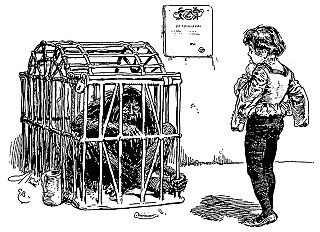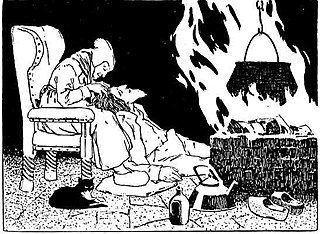Related Research Articles

"Iron John" is a German fairy tale found in the collections of the Brothers Grimm, tale number 136, about an iron-skinned wild man and a prince. The original German title is Eisenhans, a compound of Eisen "iron" and Hans. It represents Aarne–Thompson type 502, "The wild man as a helper".

"The Devil with the Three Golden Hairs" is a German fairy tale collected by the Brothers Grimm. It falls under Aarne–Thompson classification types 461, and 930.

The Prince Who Worked as Satan's Servant and Saved the King from Hell is a Lithuanian fairy tale collected by German linguists August Leskien and Karl Brugmann. Andrew Lang included it in The Grey Fairy Book under the title The Magician's Horse.

"The Water of Life" is a German fairy tale collected by the Brothers Grimm, tale number 97.

The King of England and his Three Sons is a Romani fairy tale collected by Joseph Jacobs in More English Fairy Tales. He listed as his source Francis Hindes Groome's In Gypsy Tents, where the informant was John Roberts, a Welsh Roma. Groome published the tale as An Old King and his three Sons in England.
The Wicked Sisters is a Russian fairy tale collected by Alexander Afanasyev in Narodnye russkie skazki.

The Greek Princess and the Young Gardener is an Irish fairy tale collected by Patrick Kennedy in Fireside Stories of Ireland. Joseph Jacobs included it in More Celtic Fairy Tales.
Prâslea the Brave and the Golden Apples is a Romanian fairy tale collected by Petre Ispirescu in Legende sau basmele românilor.
Făt-Frumos with the Golden Hair or The Foundling Prince is a Romanian fairy tale collected by Petre Ispirescu in Legende sau basmele românilor.
Little Johnny Sheep-Dung is a French fairy tale collected by Achille Millien and Paul Delarue.
The Beautiful Palace East of the Sun and North of the Earth is a Swedish folktale collected from Smaland by Swedish folktale collectors George Stephens and Gunnar Olof Hyltén-Cavallius. It features versions of the swan maiden, a mythic female character that alternates between human and animal shapes.
Donotknow is a Russian fairy tale (skazka) collected by folklorist Alexandr Afanasyev in his three-volume compilation Russian Fairy Tales. The tale was also translated as "Know Not" by Jack V. Haney. It deals with a friendship between a merchant's son and a magic horse that are forced to flee for their lives due to the boy's stepmother, and reach another kingdom, where the boy adopts another identity by only uttering the words "Ne znay".
Adventures of a Boy is the title of an Azeri folktale first collected in Russian language in the early 20th century.
Povestea cu măr moramăr și păsărica a ciută is a Romanian fairy tale published as part of the collection Povești nemuritoare .
The Wonderful Sea-Horse is an Iranian folktale collected from storyteller Mashdi Galeen Khanom and published by Laurence Paul Elwell-Sutton. It is classified in the international Aarne-Thompson-Uther Index as ATU 314, "Goldener". It deals with a friendship between a king's son and a magic horse that comes from the sea; both are later forced to flee for their lives due to the boy's own sisters, and reach another kingdom, where the boy adopts another identity.
The Prince and the Foal is a Greek folktale from Epirus, first collected by Austrian consul, Johann Georg von Hahn and published in the mid-19th century. It deals with a friendship between a king's son and a magic horse that are forced to flee for their lives due to the boy's own mother, and reach another kingdom, where the prince adopts another identity.
Der Hengst Houssan is a Sudanese folktale from Kordofan, first collected in German by ethnologist Leo Frobenius and published in 1923.
Nemtudomka is a Hungarian fairy tale, first published in the mid-19th century by author János Erdélyi. It is classified in the international Aarne-Thompson-Uther Index as ATU 314, "Goldener". It deals with a friendship between a king's son and a magic horse that are forced to flee for their lives due to the boy's own mother, and reach another kingdom, where the boy adopts another identity by only uttering the words "Nem tudom".
Green-Vanka is a Russian fairy tale (skazka), first collected in the 1930s and published in 1998. It deals with a friendship between a merchant's son and a magic horse that are forced to flee for their lives due to the boy's stepmother, and reach another kingdom, where the boy adopts another identity by only uttering the words "Green-Vanka", and defeats three dragons to protect three princesses.
About the Golden-Haired Boy is a Polish fairy tale first collected by ethnographer Karol Mátyás. It is classified in the international Aarne-Thompson-Uther Index as ATU 314, "Goldener". It deals with a friendship between a king's son and a magic horse that are forced to flee for their lives due to the boy's own mother, and reach another kingdom, where the boy adopts another identity.
References
- ↑ Andrew Lang, The Crimson Fairy Book (1903), "The Hairy Man"
- ↑ Aarne, Antti; Thompson, Stith. The types of the folktale: a classification and bibliography. Folklore Fellows Communications FFC no. 184. Helsinki: Academia Scientiarum Fennica, 1961. pp. 169–170.
- ↑ Thompson, Stith (1977). The Folktale. Berkeley, Los Angeles; London: University of California Press. pp. 60–61.
- ↑ Stith Thompson, The Folktale, p 60-1, University of California Press, Berkeley Los Angeles London, 1977
- ↑ Stith Thompson, The Folktale, p 59-60, University of California Press, Berkeley Los Angeles London, 1977.
- ↑ "Башкирское народное творчество ". Tom 4: Волшебные сказки. Сказки о животных [Vol. 4: Tales of Magic and Animal Tales]. Сост. Н.Т. Зарипов. Вступ. ст., коммент. Л.Г. Барага и Н.Т. Зарипова. Уфа [Ufa]: Башкирское книжное изд-во, 1989. pp. 51-54 (tale nr. 4). ISBN 9785295002939.